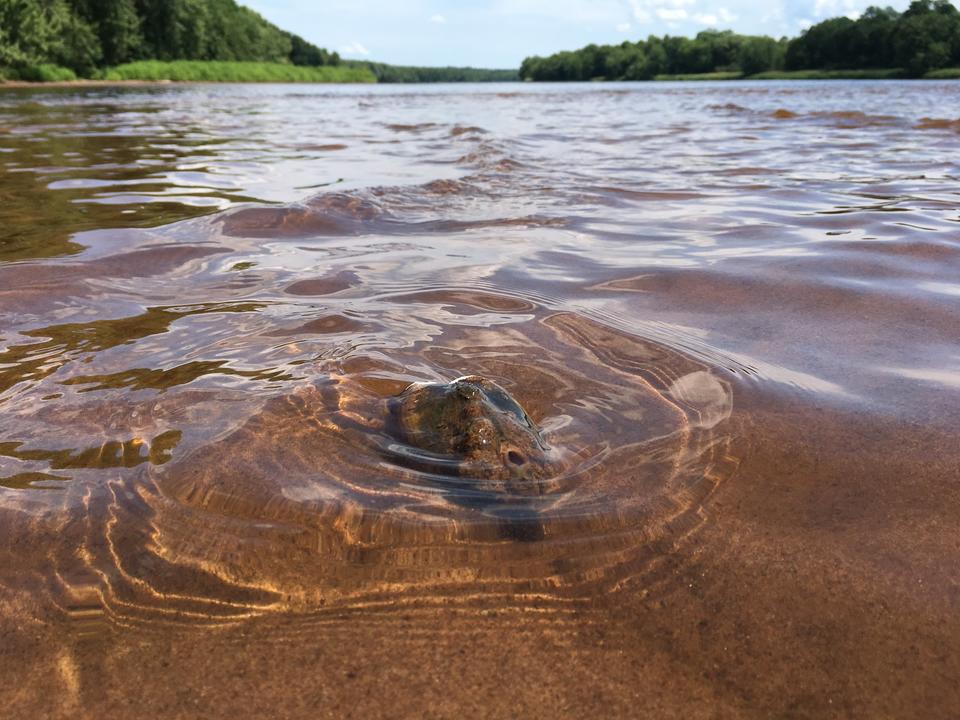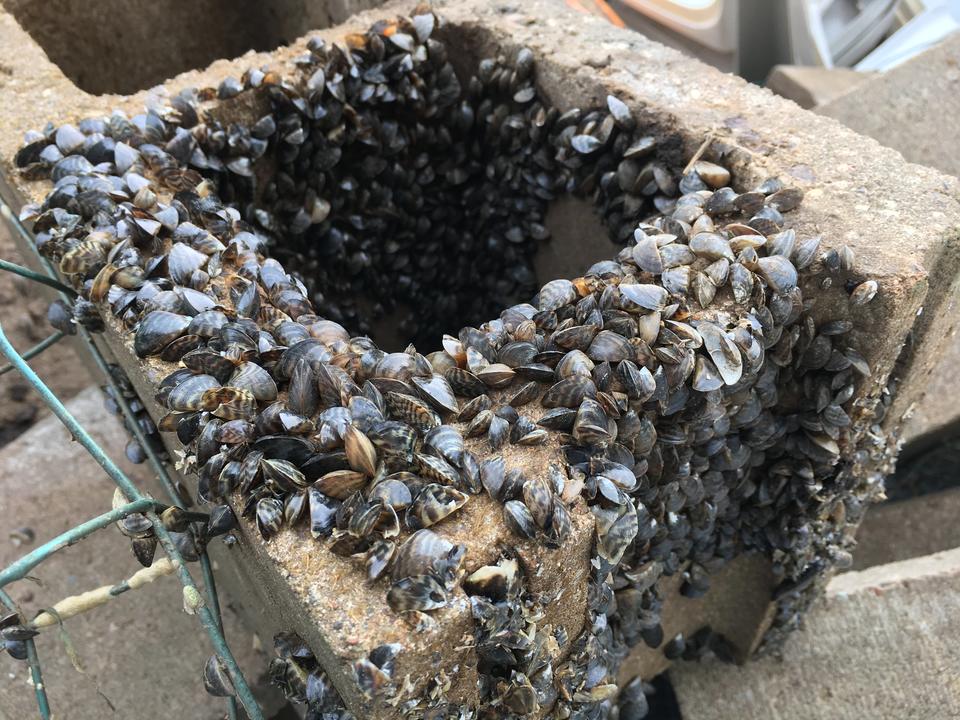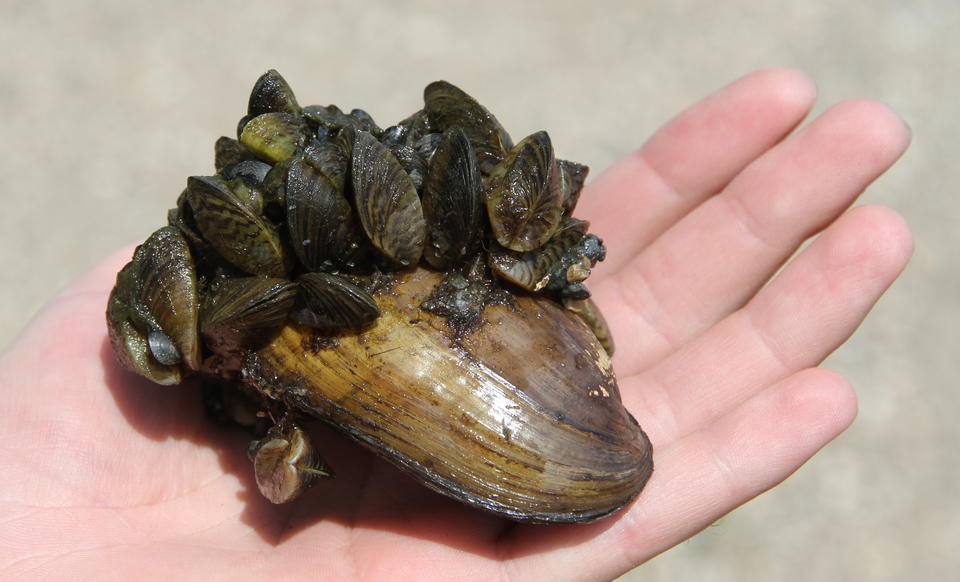By Angelique Dahlberg, MAISRC Grad Fellow and doctoral student
I remember the night I fell in love with freshwater mussels. It was an early winter evening—the kind where the dark and cold were just settling in, that time when children look to the sky and exclaim with wonder over the softly drifting young snowflakes, long before the weeks of unrelenting cold make summer a distant memory.
That night, bundled in my winter jacket, I listened to the remarkable story of one of our continent’s greatest treasures. The lights were dimmed for the presentation, obscuring the 70s-era decorating and carpeted walls, directing our focus to a slightly crooked projected presentation.
I had gone to the presentation out of curiosity; at the time, I was working as an invasive species coordinator, and regularly worked to monitor, prevent the spread of, and raise awareness about invasive zebra mussels. Their native counterparts, though, I knew less about.
I’m not sure what others thought of the presentation – but I hung on to every word, almost enchanted as a new world opened before me.
North America is home to more freshwater mussels than anywhere else in the world, and here in Minnesota, we have 50 unique species.
Mussels, also called clams, belong to a group of two-shelled animals called bivalves. North America has somewhere around 300 species of mussels; twice that of any other region in the world. To add to that, most of those species are endemic – found nowhere else.
Despite this incredible diversity, it’s easy to overlook mussels. The animals spend most of their lives burrowed in the bottoms of rivers and lakes, feeding on small particulate matter, and filtering the water. When they do emerge, one of their prime directives is reproduction. Mussels typically spawn in spring and summer, and the developing young are initially brooded within the mother’s gills. Once they reach a certain age, a stage during which they are called “glochidia,” the mother sends them into the world.
During this life stage, most species of native mussels are parasitic. They clamp onto suitable hosts (mostly fish species) where they grow and mature. Eventually, they drop off their host and spend the rest of their lives on the river or lake floor.
To further complicate this process, each mussel species has extraordinary and unique fine print on their reproduction instructions. Some species can parasitize many fish species; others rely on only one very specific fish. Some mussels have evolved elaborate lure-like structures to draw in fish before they release their glochidia; others broadcast glochidia widely; still others release glochidia in packets called “conglutinates.”
In general, the essential role that fish play in mussel reproduction means that the mussels can only go where the fish go. In today’s world, dams that block fish passage also block mussel passage – dividing and isolating populations and sometimes leading to extinctions.
While dams are a relatively recent invention, waterfalls are not. The distribution of mussel species across the landscape today is largely determined by the rivers and waterfalls of the past.
North American mussels first appear in the fossil record 250-200 million years ago, during the Triassic Era (think: dinosaurs). Mussels that lived along the Pacific coast were subject to tectonic activity. Mussels that lived along the Atlantic coast were subject to changing sea levels and frequently shifting habitats. And species in the Mississippi River basin experienced comparatively stable conditions that allowed them to prosper and radiate into new species. Today, 19 of the 20 most diverse mussel rivers in North America are in the Mississippi River basin.
During the last ice age, those Mississippi River mussel populations were all pushed south. As the ice sheet began to melt, mussels and fish were able to once again move north. Huge amounts of meltwater coming from the receding ice sheet connected rivers and lakes that are no longer connected today and allowed mussels to migrate widely. Once the meltwater had passed and water levels fell, the major river basins emerged in their current configurations, and dispersal was curtailed.
Here in Minnesota, St. Anthony Falls formed in the Mississippi River between 11,000-11,700 years ago. Before the falls formed, fish and mussels could move freely up- and down-stream. Once the falls emerged, there was no more movement upriver. Today, the mussel species that live upstream of St. Anthony Falls are all species that arrived prior to the falls’ formation; slower species that arrived later are found only below the falls. The distributions we see today are the products of our past.
Except.
Except, that as human movement has increased, so has other species’ movement - almost always at the hands of humans, wittingly or unwittingly.
As species movement has increased, a few dramatic winners have emerged - species that can not only establish in new areas, but thrive - often at the expense of native species. We call these harmful non-native species “invasive species.”
Invasive species not only pose major threats to ecosystems and their functioning, but they are also linked to declines in diversity, native species abundance, and the basic services that ecosystems are able to provide.
One particularly problematic invasive species is the zebra mussel—the very mussel that led me, through intrigue, to attend that winter lecture on native mussels.
Unlike our native mussels, zebra mussels hail from the Ponto-Caspian region in eastern Europe. They were introduced to the Great Lakes in the ballast water carried in internationally travelling cargo ships in the mid-1980s. Their prolific reproduction and rapid growth rate have allowed them to quickly establish in hundreds of waterbodies across North America.
Zebra mussels use threadlike protein strands, called “byssal threads,” to attach to things. Rather than living burrowed in river and lake bottoms, zebra mussels attach to rocks, plants, docks, and—if they’re exposed—native mussels. When zebra mussels attach to native mussels, they can impair the native mussel’s ability to move, breathe, and eat.
To add insult to injury, because both types of mussels feed on the free-floating particulate matter in the water, zebra mussels directly compete with native mussels for food.
I went into that auditorium that winter night as an invasive species manager, but I came out as a budding native mussel enthusiast with a renewed resolve for keeping zebra mussels out of our waters.
Native mussels may not be your reason for caring about zebra mussels (or, more broadly, invasive species), but they are mine. A few years after that lecture, I left my job and returned to school. Today, I am a doctoral student with the Minnesota Aquatic Invasive Species Research Center. Here, we work on cutting-edge solutions for some of Minnesota’s most challenging invasive species issues. I now work on a team that is developing management tactics for suppressing zebra mussels. While we target zebra mussels, we also closely monitor our native species - including freshwater mussels - to watch for any unintended consequences. Suppressing zebra mussel populations is important, but our goal is to protect our native species as well.



